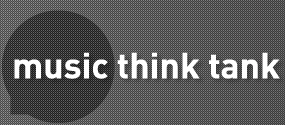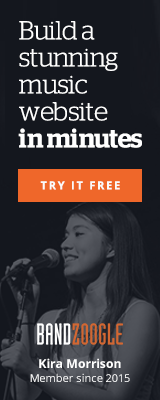 February 26, 2019
February 26, 2019 8 Essential Pages For Your Music Website
This guest post from Dave Cool is an excerpt from Bandzoogle’s free online guide How to make a website for your music
When you’re designing a website for your music, one of the most important decisions you’ll need to make is what menu options to have, and how to organize them. Here are some key points to keep in mind when mapping out the navigation for your site:
Make navigating your website easy
When deciding on your menu options, it’s important to make navigating your website as easy as possible for everyone who visits your site.
To accomplish this, it’s best to limit your main menu options to about 8 choices. More than that and it starts to get messy. Having just 5 or 6 main menu buttons is fine. Any less, though, and you’re likely leaving out key information and content from your site, or some of the pages will end up being too cluttered.
Have one clear purpose per page or section
When creating your menu options, a good rule to follow is to have one clear purpose per section of your website. So your Bio page (or section) should focus on your bio. Don’t add a store or events calendar where you want visitors to focus on your story as an artist.
Keep the names simple
When naming your main menu buttons, remember to keep it simple. People have very short attention spans, and not a lot of time. If they have to guess at what content might be in a certain section of your site because the name is fancy/cute, chances are they’re going to skip it altogether.
So stick to page names like “About”, “Music”, “Shows”, “Store”, and avoid vague names like “Experience”, “Discover”, “My World”, etc. Better to leave that creative energy on the content of the page for visitors to read once they’ve clicked the menu item.
Creating the pages for your music website
Here are the essential pages or sections to include on your website:
1. Homepage
2. Bio
3. Music
4. Shows
5. Photos
6. Videos
7. Store
8. Contact
1. Homepage
Your Homepage is arguably the most important page on your website as it’s where people most often land first. This is where you can guide visitors to the information you want them to see, and what action you want them to take.
An effective Homepage should have the following elements:
-
Great header image
-
Strong call-to-action
-
Short bio
-
Music player
-
Video
-
Latest news
-
Social media links
2. About/Bio
Next up is your ‘About’ or ‘Bio’ page. This is important for potential new fans to get to know your background, as well as for media and industry people to read your story.
On this page you can have several versions of your bio (long and short), as conferences, festivals and media outlets have different needs for artist information. It’s also a good place to add a different photo of your or or band.
For some tips on writing a bio, check out How to Write an Effective Musician Bio (with examples!)
3. Music
When it comes to having music on your website, having a sitewide music player or embedding a player on your Homepage isn’t enough. Your website is your main hub on the Internet. If there’s any place that fans should be able to find all of your music, lyrics, and album info, it’s on your own website.
Selling your music online
On your Music page, don’t just send fans away to iTunes or Amazon to buy your music. You should have ecommerce set up on your own site where you can offer digital downloads for purchase. This way you get to keep the majority of the revenue plus collect their email addresses for your Mailing List campaigns.
[The Complete Guide to Selling Your Music Online]
Physical options
You should also include physical options like CDs or vinyl, and offer signed versions for those items for your super fans. With Bandzoogle’s Store feature, you can sell physical items commission-free, put items on sale, track inventory, and more.
4. Shows/Calendar
If you perform live, another essential element to have on your website is a ‘Shows’ or ‘Tour’ section. Make it easy for fans to get info about your upcoming gigs, with details on showtimes, cover charges, opening bands, and the venue.
This is also a great page to showcase one of your best live videos so fans (and bookers) can get a taste of what to expect if they come see your show.
5. Photos
It’s no secret that fans love to look at photos of their favorite bands. So be sure to include a ‘Photos’ section, which will also help keep fans browsing your website longer.
To help organize your photos, create different galleries for promo shots, live photos, fan photos, etc. You can also connect your Instagram feed to keep the content on this page fresh.
6. Videos
One common mistake on music websites is to simply send people away to YouTube to watch videos. In doing that, you’re sending them to a site that is filled with distractions, ads, and lots of unrelated videos to watch.
Instead, create a ‘Videos’ section on your site and embed your best videos there. This allows you to curate which videos people see, because there might be hundreds of live videos filmed by fans on YouTube that might not best represent your band.
7. Store
If there’s any place online that fans should be able to buy your merch, it’s through your website. As with selling your music, selling merch directly to your fans means you not only get most of the money, you also get their email addresses to keep in touch with those fans over the long term.
Some quick tips for setting up your Store page:
-
Keep the page simple and easy to navigate. If it’s messy people might leave the page without making a purchase.
-
Have at least one image for each item in your Store.
-
Add context: describe each item and explain why your fans will love it.
-
Add a clear way to contact you. When people are shopping online, they want to know that they can easily contact the seller if they have any questions.
For merch ideas and more details on setting up your online store, check out The Ultimate Guide to Selling Band Merch Online
8. Contact
Last but not least, make sure to include a ‘Contact’ page on your site. Some people bury contact info in the footer of their site, but it’s best to make it easy for site visitors to get in touch with you, especially considering media or industry professionals.
So, create a specific ‘Contact’ page and include info on how best to reach you for booking, media inquiries, and fan correspondence. To avoid spam bots, use a custom form rather than having your email address listed on the page. You can also add your social links and a mailing list sign-up form to this section.
Dave Cool (yes, his real name) is the Director of Artist & Industry Outreach at music website platform Bandzoogle. A former punk rock drummer, Dave has spoken at dozens of conferences including SXSW, CMW, and SF Music Tech, and has been interviewed by The Economist and the Financial Post about the music industry.
 Advice,
Advice,  Marketing,
Marketing,  Websites tagged
Websites tagged  Advice,
Advice,  band website,
band website,  digital marketing,
digital marketing,  marke,
marke,  music website,
music website,  website
website 





Reader Comments (1)
Any less, though, and you’re likely leaving out key information and content from your site, or some of the pages will end up being too cluttered. run 3 engaging running game